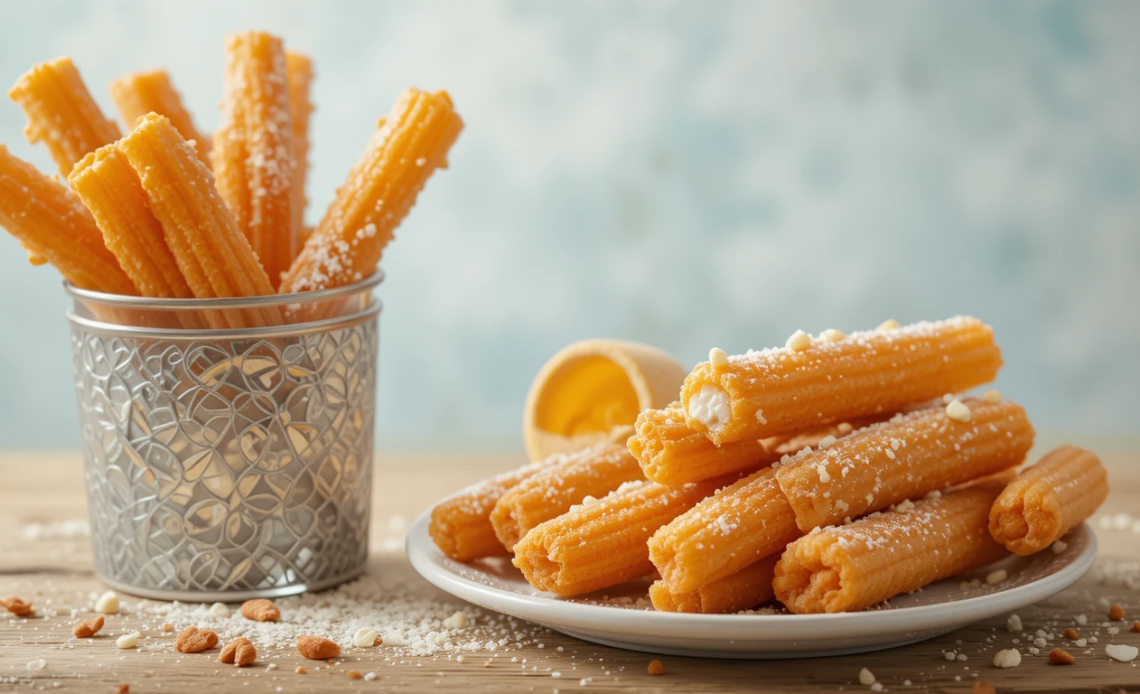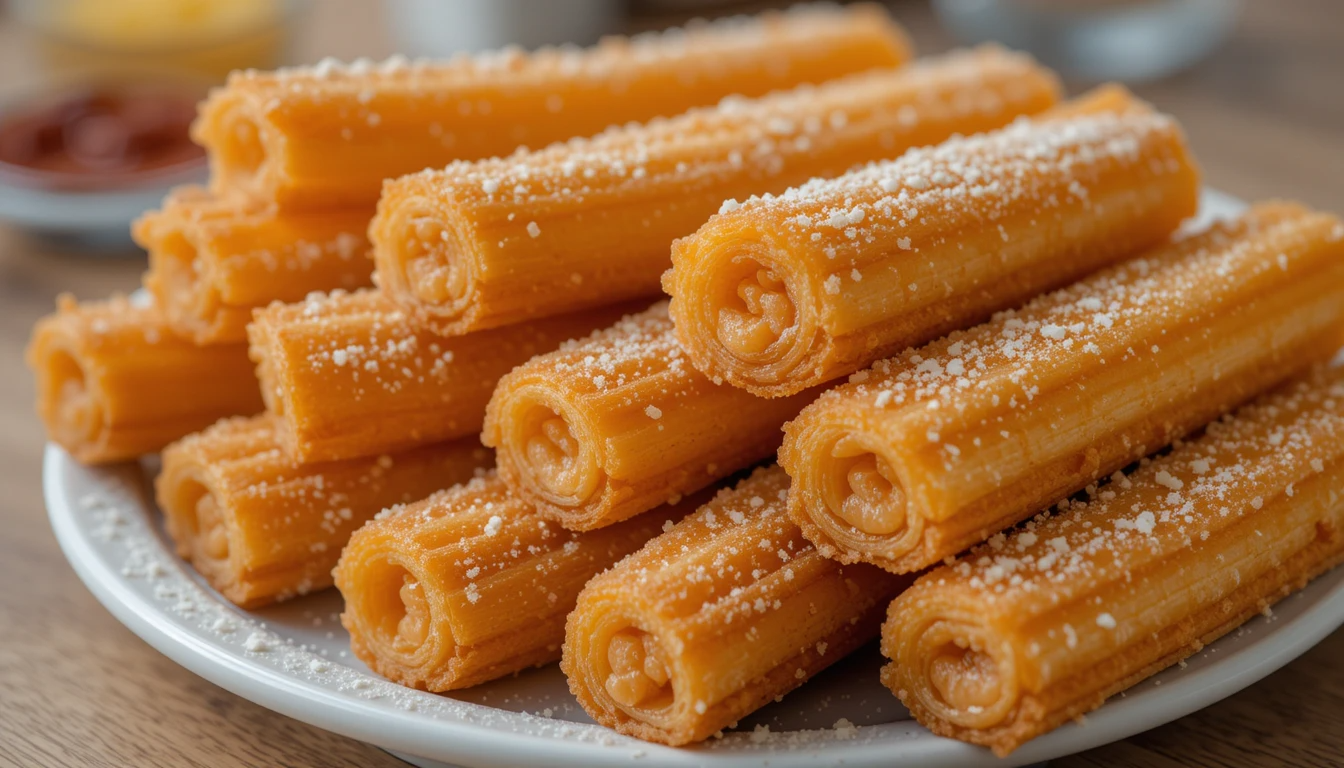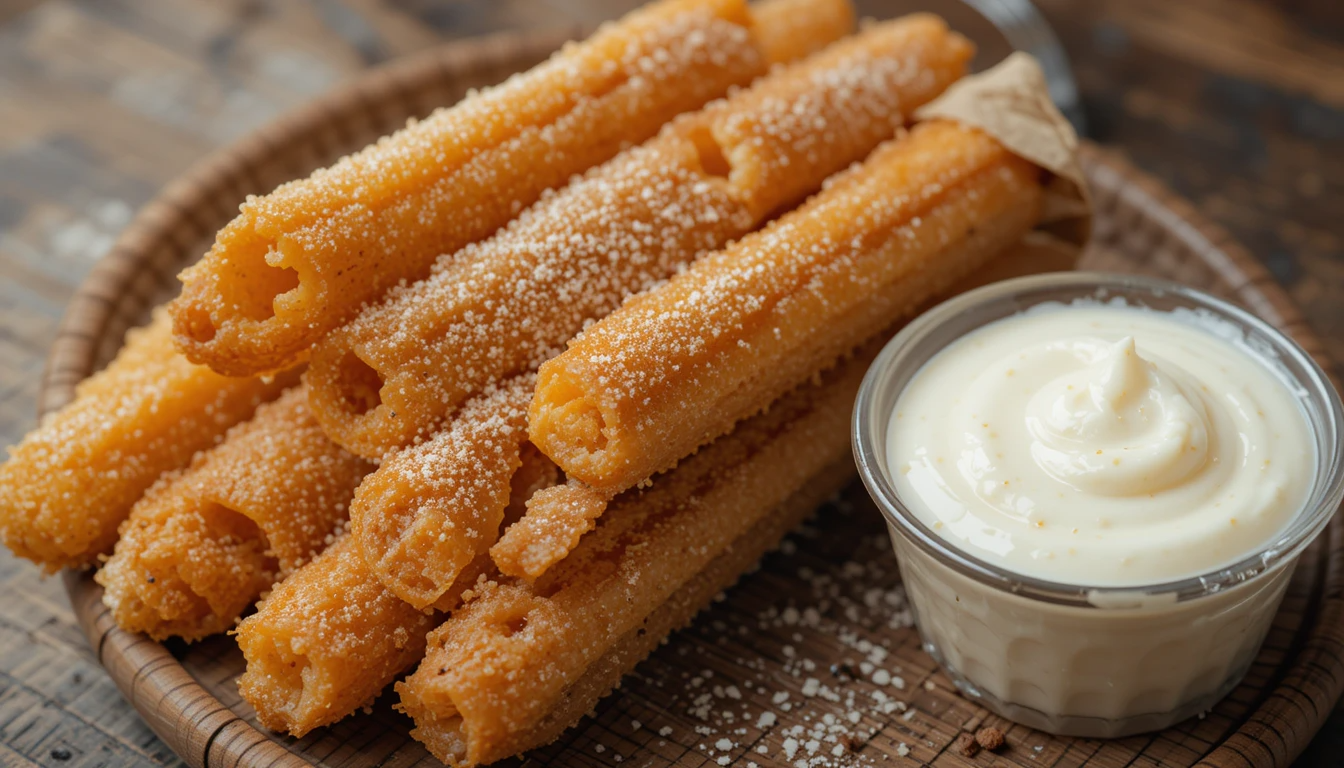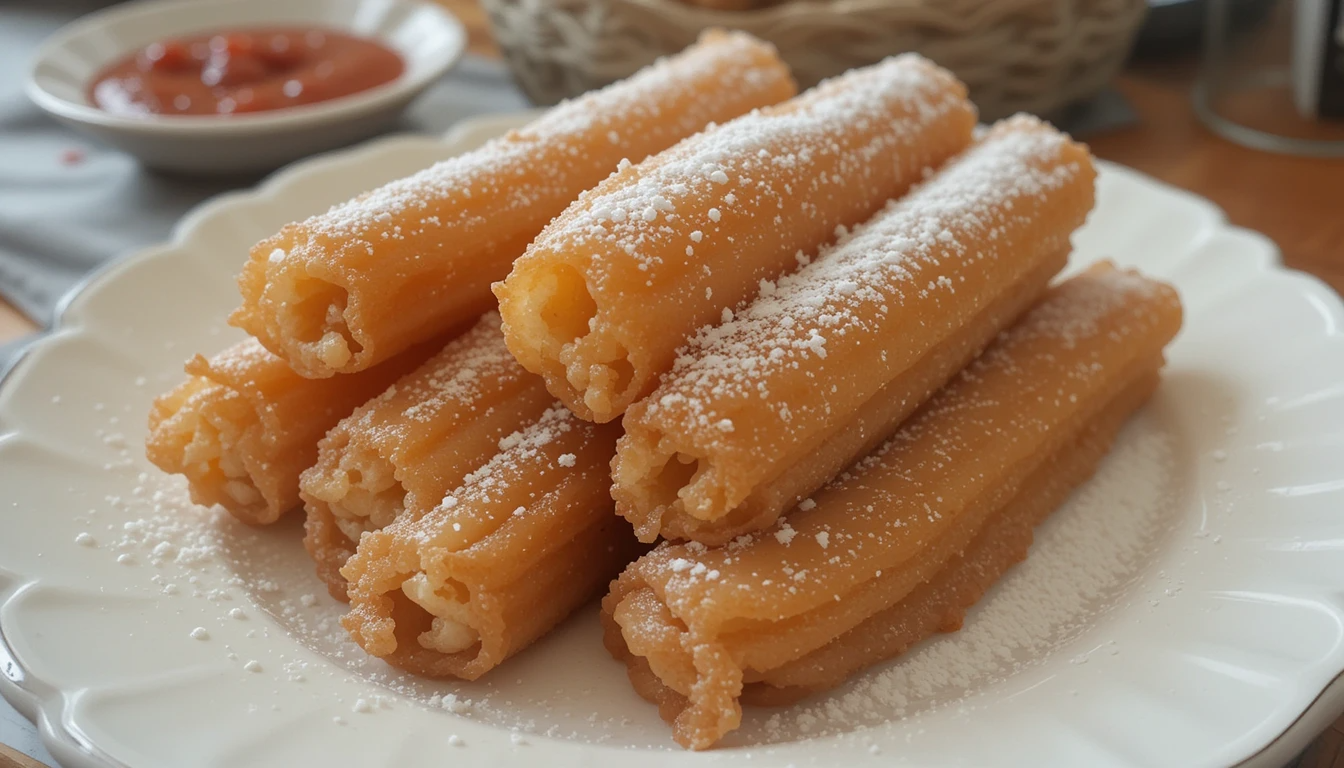
Churros are a beloved fried-dough pastry known for their crispy exterior and soft, doughy center. They typically come dusted in sugar or cinnamon-sugar and are often paired with rich dipping sauces like chocolate or caramel. Whether you enjoy them at a bustling street fair or in a cozy kitchen at home, these golden delights offer a comforting taste experience that’s hard to forget.
Table of Contents
Introduction
Imagine walking through a bustling fair or an open-air market with the smell of sweet dough frying in the air. You catch a whiff of something tempting—sugary, warm, and undeniably festive. Suddenly, you’re drawn toward a small cart where a stack of ridged, golden pastries glistens under the lights. Churros are calling your name, and their allure has been captivating taste buds across the globe for centuries.
Though Churros often carry an air of casual fun—think state fairs, theme parks, or vibrant city streets—these fried treats actually have a complex history that ties together influences from multiple cultures and eras. Some say they trace back to Spanish shepherds, while others argue a connection to Chinese fried pastries. Regardless of their origins, Churros have found universal acclaim as a sweet indulgence that can light up mornings and late-night snack cravings alike.
In the coming sections, we’ll dive into the background of Churros, explore their variations, and delve into the techniques that make them as iconic as they are. You’ll learn about everything from the basic dough composition to the best dips for maximizing flavor. By the end, you’ll not only appreciate the crispy sweetness of Churros, but you’ll also gain the expertise to enjoy them in a variety of ways—and maybe even make your own.
(Disclaimer: This article is for informational purposes only and does not replace professional veterinary advice. Always consult relevant experts for comprehensive guidance regarding dietary concerns.)
The History and Evolution of Churros

A Cultural Tapestry
Churros have an intricate background that combines storytelling, travel, and cultural exchange. One long-held theory, detailed in sources such as Smithsonian Magazine (an authoritative and reputable publication), suggests that Portuguese explorers tasted a similar fried pastry in China. Upon bringing the idea back to the Iberian Peninsula, Spanish locals refined the concept, resulting in what we now recognize as modern Churros.
- Some food historians maintain that Churros originated from Spanish shepherds.
- Others argue for an Asian influence via Portuguese traders.
- The dough’s simplicity—often just flour, water, and salt—makes it easy to whip up even in remote locations, contributing to the treat’s popularity.
Whether Spanish or otherwise, the moment these dough sticks received their iconic star-shaped ridges—facilitated by a special piping tip—they became visually distinctive. Over time, different regions added their unique twist, from filling them with dulce de leche in Latin America to dipping them in thick hot chocolate in Spain. The global love for Churros underscores just how far a simple but indulgent recipe can travel.
The Modern Churro Craze
Fast forward to the 21st century, and Churros have evolved into a worldwide phenomenon. From trendy food trucks in Los Angeles to artisanal pastry shops in London, the treat has transcended cultural boundaries. Modern variations include flavors like matcha and salted caramel, and you’ll even find Churros shaped into loops, hearts, or coiled spirals.
- Instagram-friendly dessert places now top Churros with everything from fruit compotes to candy sprinkles.
- Grocery stores in the United States have started carrying frozen Churros, allowing you to prepare them quickly at home.
- Specialty brunch menus feature Churros paired with gourmet sauces, showcasing their upscale potential.
It’s this adaptability—whether served in a paper bag at a street fair or plated elegantly at a five-star restaurant—that keeps people constantly rediscovering and falling in love with Churros. The modern craze is a testament to their timeless appeal, proving that even a pastry with centuries-old roots can continuously reinvent itself.
Anatomy of the Perfect Churro

Basic Dough Composition
At first glance, the dough for Churros may seem almost too simple: typically water, flour, and a pinch of salt. Some recipes enrich the dough with eggs or butter to yield a creamier interior. However, the trick to achieving that iconic texture lies in the preparation.
- Boiling the Liquid: Water (and sometimes milk) is often brought to a boil before being mixed with flour to form a thick paste.
- Consistent Mixing: Stirring thoroughly helps prevent lumps and ensures an even texture.
- Proper Piping: Placing the dough in a piping bag with a star tip is what gives Churros their ridged design.
The ridges are not merely decorative. They create more surface area, allowing for a crispier crust. When fried at the correct temperature (often around 350–375°F), the star-shaped logs puff slightly and develop that ideal crunchy shell while maintaining a tender, airy interior.
Frying Technique
Churros owe their signature crunch to deep frying. Temperature control is key—too hot, and they’ll burn on the outside while remaining undercooked inside; too cold, and they’ll soak up oil and turn soggy. A good practice is to heat the oil to around 365°F, which is hot enough to seal the surface quickly but not so hot that the interior can’t cook properly.
- Oil Choice: Many prefer vegetable or canola oil due to their high smoke point and neutral flavor.
- Batch Frying: Fry just a few Churros at a time to keep the oil temperature stable.
- Drain and Cool: Once they become golden brown, drain on a paper towel before coating them in sugar or cinnamon-sugar.
A final dusting of sugar provides that sweet, grainy contrast to the crunchy exterior. Some purists argue that simply plain sugar—and lots of it—is best, while others enjoy a cinnamon-sugar mix. No matter your preference, freshly fried Churros coated immediately after cooking are the gold standard.
Common Mistakes
Like any culinary endeavor, making Churros can involve pitfalls for the uninitiated. Overly wet dough may lead to excessive oil splatter. Frying at inconsistent temperatures can produce greasy, limp pastries or scorched, hollow logs.
- Don’t Overcrowd: Putting too many Churros in the fryer at once lowers the temperature, affecting crispness.
- Mind the Dough Consistency: If it’s too runny, add a bit more flour; if it’s too stiff, a dash of milk can help.
- Use Caution with Eggs: Adding eggs when the dough is too hot can scramble them, so let the mixture cool slightly before adding egg (if your recipe includes it).
Be mindful of these details, and you’ll be well on your way to that perfectly crispy-yet-tender texture that defines quality Churros.
Variations Around the World
Regional Twists
Though Churros are deeply associated with Spanish and Latin American cuisines, many cultures have their own spins:
- Spain: Usually thinner and sometimes looped. Served with a thick hot chocolate called chocolate a la taza.
- Mexico: Generally thicker, dusted with cinnamon-sugar, and frequently stuffed with creamy fillings like cajeta or custard.
- Argentina & Uruguay: Often filled with dulce de leche and served as a street snack.
- Philippines: Introduced during the Spanish colonial period, where they are often served with local chocolate or a unique local dip.
These differences highlight the pastry’s global versatility, showing how Churros adapt to local tastes and ingredients.
Innovative Flavors
Modern creativity has expanded the Churros repertoire far beyond the classic sugar-and-chocolate combination:
- Matcha Churros: Infused with green tea powder, often complemented by white chocolate dipping sauce.
- Red Velvet Churros: Achieved by adding cocoa and red food coloring, paired with a cream cheese dip.
- Savory Churros: A handful of innovative chefs have experimented with cheesy dough, herbs, or even jalapeño flavorings.
With an adaptable dough as the foundation, flavor possibilities are nearly limitless. Whether you crave a dessert that resonates with traditional tastes or a fusion flavor that introduces a new twist, Churros offer a base to explore culinary creativity.
Table: Popular Churro Styles
Below is a quick look at various Churros styles commonly enjoyed around the world:
| Style | Region | Unique Trait | Typical Accompaniment |
|---|---|---|---|
| Classic Spanish | Spain | Thin, sometimes looped | Thick hot chocolate |
| Mexican-Style | Mexico | Thicker, dusted in cinnamon-sugar | Cajeta or caramel sauce |
| Filled with Dulce | Argentina, Uruguay | Stuffed with dulce de leche | Coffee or mate |
| Chocolate-Filled | Various | Interior or drizzle of chocolate | Chocolate sauce on the side |
| Matcha-Infused | Modern Fusion | Green tea powder in the dough | White chocolate dip |
| Savory Churros | Experimental | Herbs and cheese instead of sugar | Tomato or spicy dipping sauce |
This snapshot underscores how Churros can transform to suit local palates. Whether you’re exploring a new region or feeling adventurous in your own kitchen, consider sampling different styles to discover your personal favorite.
The Dipping Sauces: A Whole New World
Classic Chocolate
In Spain, Churros are most traditionally paired with a thick, pudding-like hot chocolate known as chocolate a la taza. This is not your average hot cocoa. Its rich and dense texture is specifically designed for dipping rather than sipping. The flavor is bold, often achieved by using high-quality chocolate with little added sugar, ensuring it contrasts perfectly with the sweetness of the Churros.
Caramel & Cajeta
Across Latin America, caramel sauces such as cajeta (goat’s milk caramel) or dulce de leche reign supreme. These sauces add a luxurious, creamy component that pairs seamlessly with the crunchy fried dough. In Mexico, it’s common to find street vendors offering freshly piped Churros filled with cajeta, turning each bite into a gooey, sugary feast.
Fruit-Infused Dips
For those seeking a lighter option, fruit-infused dips can be a refreshing twist. Strawberry compote, raspberry coulis, or even pineapple-coconut blends can complement the buttery taste of Churros. These fruity options provide a tangy counterbalance that cuts through the richness, offering a delightful complexity to each bite.
- Berry Sauces: Popular for a sweet-tangy contrast.
- Tropical Blends: Pineapple, mango, or coconut-based dips offer a sunny, exotic taste.
- Citrus Zest: Incorporating lemon or orange zest in your sauce can amplify flavors without adding extra sugar.
Savory Combinations
While sweet sauces dominate, the rising popularity of savory Churros has paved the way for dips like marinara, cheese sauce, or even spiced aioli. Though not as mainstream, these unconventional pairings prove that the notion of Churros as purely sweet dessert items is continually being challenged.
Making Churros at Home: A Step-by-Step Guide

Ingredients You’ll Need
To create about 15–20 Churros, gather the following:
- 1 cup (240 ml) water
- 2 tablespoons (28 g) unsalted butter (optional)
- 1 tablespoon (12 g) sugar
- ¼ teaspoon salt
- 1 cup (125 g) all-purpose flour
- 1 large egg (optional, for extra richness)
- Vegetable or canola oil for frying
- Cinnamon-sugar mixture for coating (optional)
If you’re going for the classic Spanish version, you can skip the egg and butter, sticking strictly to flour, water, and salt. If you want to replicate Mexican-style Churros, the egg and butter will add that distinctive richness.
Method in Detail
- Boil the Liquid: In a saucepan, combine water, butter (if using), sugar, and salt. Bring to a boil over medium heat.
- Add Flour: Reduce heat to low, then stir in the flour all at once. Stir vigorously until a dough ball forms and pulls away from the sides of the pan.
- Cool & Incorporate Egg: Remove from heat and allow the dough to cool for a couple of minutes. If adding an egg, do so now, mixing quickly to prevent it from cooking into scrambled bits.
- Prepare the Piping Bag: Fit a piping bag with a large star tip. Spoon the dough into the bag.
- Heat the Oil: In a deep skillet or a fryer, heat oil to around 365°F.
- Pipe & Fry: Carefully pipe the dough into the hot oil, cutting off strips at your desired length with kitchen scissors or a knife. Fry a few Churros at a time until golden brown, turning occasionally for even cooking.
- Drain & Coat: Remove with a slotted spoon and drain on paper towels. While still warm, dust or roll the Churros in cinnamon-sugar or plain sugar.
Pro Tips for Success
- Temperature Control: Use a thermometer to ensure your oil remains at a consistent temperature.
- Test a Small Strip: Before committing to a full batch, fry a test piece to check for seasoning and texture.
- Serve Immediately: Churros taste best when they’re fresh and hot, so plan to fry them close to serving time.
Making Churros at home can be an exciting project, yielding delicious results that rival your favorite street cart or carnival stand. The sense of accomplishment alone adds a special flavor to each crispy bite.
Health Considerations & Moderation
Nutritional Snapshot
While undeniably tempting, Churros should generally be treated as an occasional indulgence. A standard 2–3-ounce serving of Churros can contain around 150–250 calories, largely depending on the sugar coating and any fillings. Fried foods are also relatively high in fat, often containing at least 6–10 grams of fat per serving.
- Carbohydrates: Primarily from refined flour, which is digested rapidly.
- Sugars: Coating and dipping sauces can significantly increase sugar intake.
- Fats: Deep frying elevates the total fat content.
Balanced Enjoyment
Though Churros aren’t typically viewed as a health food, there’s room for them in many diets if enjoyed in moderation. Pairing Churros with healthier meal choices on the same day, incorporating a brisk walk, or balancing them with nutrient-dense foods can mitigate excessive calorie intake. Some restaurants and home cooks also experiment with baked Churros, which may slightly lower the fat content.
- Occasional Treat: Consider Churros an indulgence, not a staple in your daily diet.
- Portion Control: Enjoy one or two Churros instead of multiple servings.
- Frying Oils: Using fresh, high-quality oil for frying helps reduce the likelihood of rancid fats.
Ultimately, the key is mindful consumption. When savored as a festive treat rather than a daily habit, Churros can fit well within a balanced lifestyle.
Expert Opinions & Studies
Culinary Experts Weigh In
Top chefs like Ferran Adrià in Spain have often highlighted the cultural significance of Churros as part of the nation’s gastronomy. Meanwhile, pastry experts in Mexico have showcased how the thick, creamy textures of local sauces pair perfectly with the crispy dough. Culinary schools worldwide frequently include a module on fried doughs, underscoring the technical skill required to execute them flawlessly.
Nutritional Experts’ Perspective
While few formal studies focus explicitly on Churros, general research on fried foods indicates that excessive consumption of high-calorie, fried snacks can contribute to weight gain and cardiovascular issues. According to the American Heart Association, moderation is essential, and occasional indulgences like Churros can be balanced with an overall healthy dietary pattern.
- Tip: Emphasize whole grains and lean proteins in other meals if you plan on indulging in fried treats.
- Disclaimer: Individual dietary needs vary, so it’s wise to consult a healthcare professional for personalized advice.
By combining culinary insight with nutritional guidelines, you can embrace the delight of Churros without compromising your long-term health goals.
FAQs
What do churros taste like?
Churros taste sweet, with a light, crispy exterior and soft center. They carry a buttery or slightly salty undertone that contrasts their sugary coating. When dipped in chocolate or caramel, Churros deliver an even richer flavor burst.
Are churros a Mexican thing?
Churros have roots in Spain but are also beloved in Mexico. Mexican-style Churros are often thicker and dusted with cinnamon-sugar, frequently served with decadent fillings. You’ll find Churros in many parts of Latin America, each region adding its own flair.
Are churros like doughnuts?
Both doughnuts and Churros are fried pastries, but Churros have ridges and a firmer texture. Doughnuts often have a soft, cakey interior or a yeast-based fluffiness. Churros stand out with their cylindrical shape and signature crunch.
Did churros come from China?
Some believe Churros evolved from a Chinese pastry called youtiao, introduced to Europe by Portuguese explorers. While Spain popularized and refined Churros, the theory points to possible Chinese roots. Even so, Churros as we know them are firmly tied to Hispanic cuisine.
Conclusion
If you’ve ever taken a bite of a piping-hot Churros stick—slightly crunchy on the outside, soft and warm on the inside, coated in sugar that leaves a sweet dust on your lips—you already know why these treats hold a special place in culinary hearts around the world. From historical debates on their origins to contemporary twists in gourmet restaurants, Churros have proven their ability to evolve and enchant. Their simplicity in ingredients yet complexity in form and flavor make them a testament to how the best things in life can be both humble and spectacular.
As you explore the various methods of making Churros, or sample different shapes, flavors, and dips, remember that a little bit of playful experimentation can yield delicious results. Whether you choose a traditional Spanish hot chocolate, a sweet caramel sauce, or a modern fusion dip, each approach highlights the pastry’s adaptability. Give Churros a try at home or seek them out in your next culinary adventure—you might just discover a new favorite treat.
Key Takeaways
- Churros boast a long history that intertwines multiple cultures.
- Whether sweet or savory, they’re adored globally for their texture and taste.
- Mastering the dough and frying technique is critical for that iconic crunch.
- Dipping sauces—chocolate, caramel, or even fruit-infused—enhance their appeal.
- Moderation is advisable due to the high calorie and fat content.
- Churros can be a delightful addition to your culinary repertoire, enjoyed responsibly.
